Director’s Introduction
Taft Armandroff, Director, WMKO
 Over the past year, the Keck Science Steering Committee
(SSC) and Keck Observatory leadership have conducted
activities to update the Observatory’s scientific
strategic plan. The strategic planning activities are
essential in providing the Keck community an opportunity
to consider the state and productivity of the Observatory,
review the broad astronomical landscape, and focus on
scientific opportunities in the coming decade. The
scientific strategic plan is an important touchstone for
setting priorities in the annual and five-year planning
and budgeting processes.
Over the past year, the Keck Science Steering Committee
(SSC) and Keck Observatory leadership have conducted
activities to update the Observatory’s scientific
strategic plan. The strategic planning activities are
essential in providing the Keck community an opportunity
to consider the state and productivity of the Observatory,
review the broad astronomical landscape, and focus on
scientific opportunities in the coming decade. The
scientific strategic plan is an important touchstone for
setting priorities in the annual and five-year planning
and budgeting processes.
The initial scientific strategic plan was created in 2003 and was last updated in November 2005. In addition to establishing the scientific strategic plan, the updated strategy will be provided as input to the national astronomy community’s 2010 Decadal Survey, a process that is used to input community priorities to the federal funding agencies (e.g., NASA and the National Science Foundation). The 2008 process included soliciting input from the community via telecons and a successful call for White Papers.
In September, a two-day retreat was held in Half Moon Bay, California. The participants were members of the SSC, the Observatory Directors, selected members of the Keck Observatory staff, and additional “at large” members of the science community in proportion to institutional representation on the SSC. A scientific strategic planning document was written and circulated to the entire Keck scientific community for comment. The document reaffirms the Observatory’s commitment to leadership in scientific productivity, innovative instrumentation, adaptive optics, and efficient operations.
I would like to thank the SSC and CARA Board members and community members who participated in the planning process. Input from the Keck community will remain essential in the Astro2010 Decadal Survey. I encourage community members to contribute their scientific plans and aspirations in the Astro 2010 process, particularly as it relates to the relevance of Keck Observatory to scientific advances in the coming decade. Keck Observatory has become a significant component of the national optical/infrared observing system and depends on federal funding, teamed with our private and non-federal public support. As such, it is essential that we share our plans and ambitions for the coming decade in the Astro 2010 national discourse. «
AO Operations Team Improves Laser and AO Performance
Randy Campbell, AO Operations Lead, WMKO
The Observatory formed an Adaptive Optics (AO) Operations Team in the late summer of 2007 with the goal of maximizing scientific productivity through maintaining the AO system's performance while improving the reliability and operational efficiency. In addition, the AO Operations team’s purpose is to offload operations tasks from development personnel and to protect the integrity of operational systems. The multi-disciplinary team is comprised of opto-mechanical, electronic, laser, software, administrative, and scientific staff. The team provides both nighttime observing support and daytime engineering/maintenance support. The AO Operations team communicates regularly to vet problem reports (night-log tickets), set priorities, review task progress, identify critical spares, share technical information, review general issues related to AO, and brainstorm for solutions and improvements to the system. The team has also formed an engineering change control board (AO CCB) to provide technical review of any proposed engineering changes that may affect the system.
Many of the personnel that contribute time to the AO Operations team were not AO experts prior to joining the team; thus, we have emphasized gaining knowledge of the system through training, workshops, code reviews, and general experience. Knowledge transfer has proven to be quite challenging but the ongoing process is beginning to pay dividends, both for operations and for the staff. Staff members take satisfaction in learning something new.
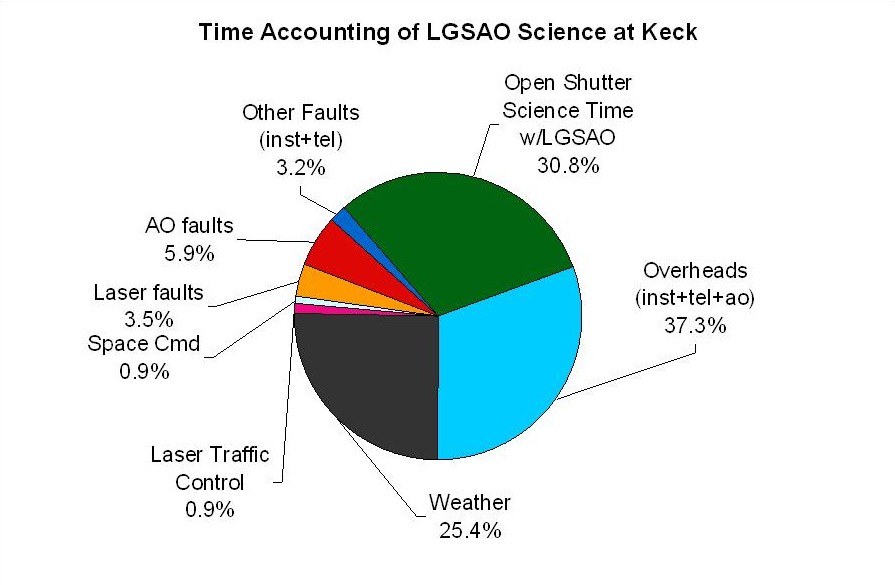
|
Figure 1. Time accounting from four years of science operations with the LGSAO system.
The AO Operations team has been in place for a little over a year. During that year the Keck AO systems continued to be scientifically productive. We track observing statistics related to observing efficiency and system reliability. These statistics are presented in three charts.
The pie chart in Figure 1 shows the fraction of AO time attributed to science and other categories over the past 4 years (i.e., since the start of LGSAO science operations). Notable is the significant amount of time lost to weather, as well as to inefficiency and faults. Because the latter two hold significant potential for improvement, the AO Operations team is investigating these areas. The bar chart in Figure 2 compares the observing statistics from year to year. Although the past year was one of the worst in terms of weather, we were fortunately able to produce more open shutter time than in previous years. Of course, many factors go into these statistics, including the type of science program, but these improvements are largely due to the diligent efforts of the AO Operations team.
It is also interesting to look at the sources of lost time in terms of faults and other issues such as closures mandated by the U. S. Space Command or the laser traffic control system (LTCS). Fault categories are presented in Figure 3. Again, the trend is toward decreasing time loss, which we find gratifying. Noteworthy is the improved laser reliability over the past few years as the laser crew, led by Kenny Grace, has the system running in top shape both in terms of performance and reliability.

|
Figure 2. Year-to-year comparison for LGSAO observing statistics
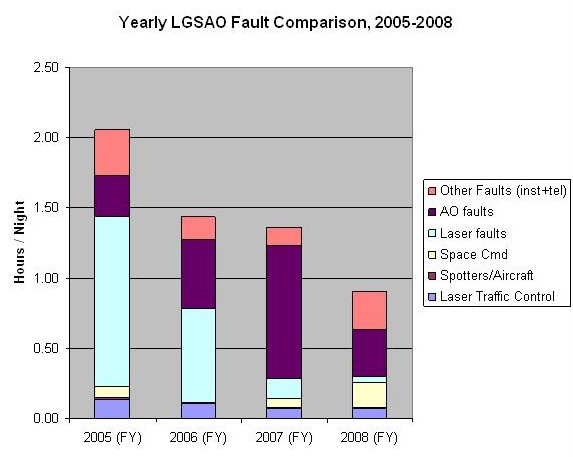
|
Figure 3. Year-to-year comparison of LGSAO system faults.
Mainland Observing Brings the Observatory to You
Gregory D. Wirth, Support Astronomer/Mainland Observing Coordinator, WMKO
Robert I. Kibrick, Research Astronomer, UCO/Lick Observatory
Can any of you still remember what it was like to observe from the summit of Mauna Kea? While some astronomers still pine for the days when one could walk outside the control room and see the stars in person, the majority of our observers prefer to operate in comfort from the remote observing facility in Waimea which began operation in 1996. Now, an increasing number of observing teams are taking remote observing a step further by making use of our “mainland observing” capability, in which observers operate the instrument from dedicated facilities in California.
The main difference between observing from Waimea and observing from the mainland is that the observing software is all run within a desktop that is simultaneously shared between the people at the two sites. This sharing is made possible by a technology called Virtual Network Computing (VNC), which is free and works well. When two sites are connected to the same VNC desktop, each can manipulate the windows on the desktop and see what the person at the other site is doing. Full details on how we enable mainland observing at Keck are provided in Operating a wide-area remote observing system for the W. M. Keck Observatory, a paper presented at the 2008 SPIE meeting in Marseilles.
Figure 4. Mainland observing system in operation.
Left: Observer in Waimea remote operations room.
Right: Observer in Santa Cruz remote operations
room. Videoconferencing systems allow audio/visual
communication. Similar layouts provide comparable
observing experience at all sites. Images courtesy
of Sarah Anderson (WMKO) and Steve Allen
(UCO/Lick).

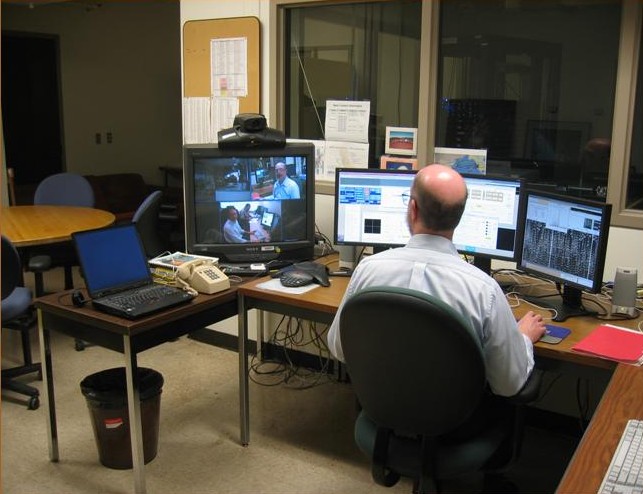
Since the first of these mainland observing facilities (Figure 4) came online at U. C. Santa Cruz in 2001, the system has expanded to include nine U. C. sites plus Caltech. Each site is designed to provide observers with an environment that closely mimics the experience of observing from Waimea, including multi-headed Sun workstations and Polycom videoconferencing units like those in Remote Ops I and II. Most of the sites offer some creature comforts such as a refrigerator, microwave, and couch (although none yet offer easy access to Hapuna beach!). In addition to adding more sites to the network, we have also expanded the selection of instruments capable of being operated remotely. We now support mainland observing on all of the traditional instruments, but not the Keck Interferometer.
While most observing teams which employ mainland observing still send one or more team members to Waimea for the observing run (what we call “eavesdrop” mode), more teams are now choosing to observe entirely from the mainland with no observer in Hawaii. This “mainland-only” observing mode is available as an option only at selected sites which are equipped with special communication backup equipment allowing observing to continue even if the Internet goes down. As shown in the table below, six of the ten existing sites support this option.
| Site | Location | Inception | Supports Mainland-Only Mode? |
|---|---|---|---|
| UCSC | Santa Cruz, CA | 2001 | Y |
| UCSD | San Diego, CA | 2003 | Y |
| CIT | Pasadena, CA | 2004 | Y |
| LBNL | Berkeley, CA | 2005 | Y |
| UCLA | Los Angeles, CA | 2006 | Y |
| UCSB | Santa Barbara, CA | 2007 | N |
| UCB | Berkeley, CA | 2007 | Y |
| UCR | Riverside, CA | 2008 | N |
| UCI | Irvine, CA | 2008 | N |
| UCD | Davis, CA | 2008 | N |
| Yale U. | New Haven, CT | * | |
| Swinburne | Melbourne, Australia | * |
Table 1. Sites supporting WMKO mainland observing (* = planned)
When we started tracking mainland observing usage several years ago, the system was used only a handful of nights per month. As the number of sites and instruments supporting mainland observing has expanded, and as observers have grown more comfortable with the experience of observing from the mainland, usage of the system has increased (see Figure 5 below) and now averages 15-20 nights per month when combining nights from both telescopes. Although we expected usage of the system to increase significantly as a result of the recent increases in airfare to and from Hawaii, this doesn’t appear to be the case.
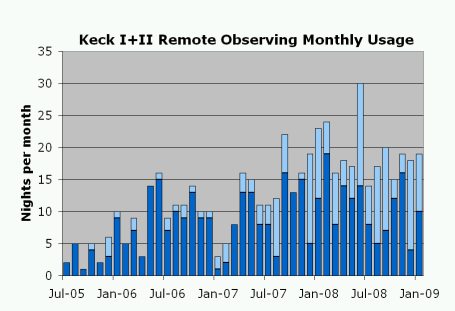
|
Figure 5. Monthly usage of the WMKO Mainland Observing sites since mid-2005. The bottom portion of the histogram indicates nights in which instruments operated in eavesdrop mode, whereas the top portion indicates operation in mainland-only mode. Together, the telescopes operate roughly 60 nights per month, so the data show that in recent months mainland observing is employed in some form on roughly 30% of observing nights. Usage has increased over time due to greater availability of sites, more instruments being upgraded to work from the mainland, and observer preferences changing to favor remote observing from California.
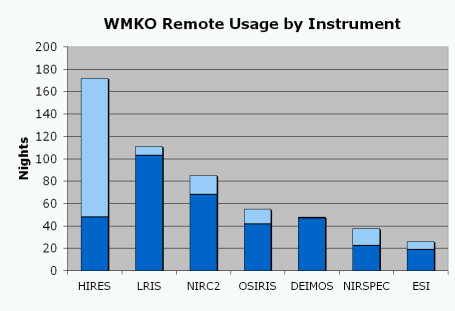
|
Figure 6. Usage of the mainland observing system by instrument since semester 2006A. Bottom portion of the histogram indicates eavesdrop mode operation; top portion denotes mainland-only mode. HIRES is the leader in terms of usage by virtue of the large number of nights it is used in mainland-only mode.
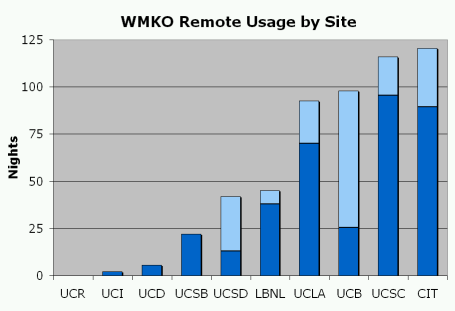
|
Figure 7. Usage of the mainland observing system by site since semester 2006A. Bottom portion of the histogram indicates eavesdrop mode operation; top portion denotes mainland-only mode. The four least-used sites have only come online relatively recently and are likely to see more frequent use in the future.
An analysis of which instruments are used most with mainland observing reveals that HIRES has surged to the lead over the last year, and that most of the increase is due to teams using HIRES in mainland-only observing mode. Several teams of “planet hunters” have started operating HIRES in mainland-only mode, thus accounting for the observed increase. The switch by the UCB-based planet hunting teams also has the UCB site challenging traditional powerhouses UCSC and CIT for the crown of most-used site for mainland observing.
In 2008 we commissioned new mainland observing sites at both U. C. Irvine and U. C. Davis, and added new computer servers on the summit to operate VNC software, thus improving the system response. In the coming months, we expect to make further changes to the remote observing software to allow observers to start their VNC sessions more easily and to make it possible to receive audio alerts (e.g., when exposures end) directly at remote sites. In the coming year we hope to add local facilities at both Yale University and Swinburne University of Technology. We will also consider inquiries from other sites wishing to establish facilities for remote operation of Keck instruments.
Observers wishing to make use of the mainland observing facilities for their run can request that option by completing the corresponding entries on their observing proposal cover sheets or by emailing the observatory well before their run (4 weeks in advance for “mainland-only” observing, or 2 weeks for eavesdropping). All requests require approval of the support astronomer and the manager of the local mainland observing site. Further information is available on the WMKO mainland observing website.
We feel that the current system has largely accomplished the objective of providing an effective, reliable, and convenient system for carrying out remote observing from the mainland. The system saves observers time and money, allows people who otherwise would be unable to attend an observing run to participate, and helps reduce the environmental impact of astronomy on the planet. What remains to be seen is how this success will affect the WMKO observing model. If observers largely stop traveling to Hawaii for their runs, will the quality of our observing support suffer? Will observers miss the opportunity to interact with the support astronomers and to cross paths with other observers? Will WMKO’s support astronomers be as effective in providing assistance, and will they feel isolated as fewer astronomers come to Waimea? These practical and sociological problems may ultimately prove more difficult for us to solve than the technical challenges we’ve overcome in creating what we believe is a mainland observing system worthy of a world-leading observatory. «
New LRIS Red Camera Expected in June 2009
Marc Kassis, Support Astronomer, WMKO
In early June 2009, the Observatory will commission the Low Resolution Imaging Spectrograph (LRIS) new red side camera consisting of a new detector mosaic, dewar, and electronics. Observers awarded LRIS nights later than 13 June 2009 should expect to use the new LRIS red camera in shared risk mode through the end of the 2009A observing semester. The new LRIS red camera will be in general use starting in the 2009B observing semester.
The new red camera for LRIS replaces the existing CCD in the red side of LRIS with a 2 × 1 mosaic of 2K × 4K fully-depleted LBNL CCDs. These CCDs were developed to improve the sensitivity and eliminate fringing in the red side of LRIS. Figure 8 shows the measured QE of one of the new CCDs; the other should perform similarly. Observers will also benefit from a modest increase in spatial and spectral coverage, more uniform image quality due to a flatter detector, and increased reliability for the detector readout electronics. The gap between the two red chips will be aligned with the gap in the LRIS blue camera mosaic so that the two cameras cover nearly the same field of view. Although we do not expect the upgrade to alter the polarimetry characteristics of LRIS, we will need to verify this assumption during commissioning.
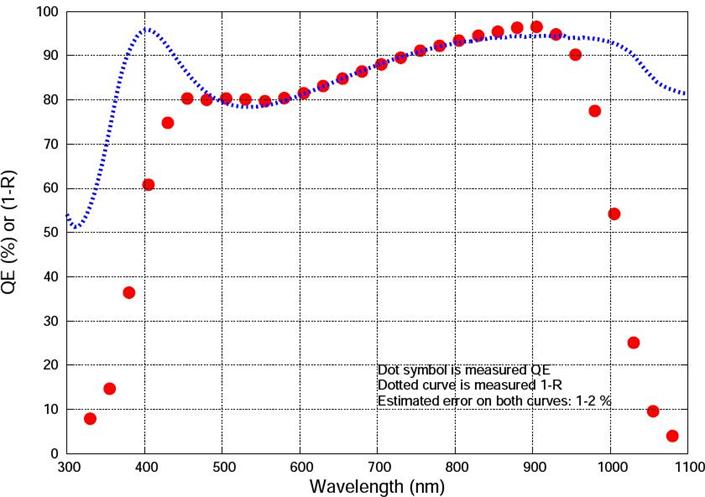
|
Figure 8. Quantum efficiency curve for one of the CCDs in the new LRIS-R detector mosaic.
Efforts continue to optimize the detector characteristics, and in the default mode of operation, the LRIS red mosaic will read out at least as fast as the existing CCD. The default operating mode may be to read out the detector in 2 × 1 binned mode, which would approximately halve the readout time, and this mode should yield a significantly lower read noise than with the current detector.
The LRIS red camera upgrade team predicts that observations with a 600 l/mm grating should be sky-noise limited in a 20 minute exposure at all wavelengths above 5000 Å, when binning by two in one dimension. As seen in Figure 8, the quantum efficiency (QE) of the new detector exceeds that of the existing CCD by at least 15% at all wavelengths, by 40% at 8000 Å and more than doubles the QE at 9000 Å. Following commissioning, updated specifications will be made available on the LRIS on-line documentation.
As part of the upgrade, DS9 will replace the FIGDISP image display utilities on both the red and blue sides of LRIS and will offer features comparable to those provided with the HIRES DS9 display package. The ability to produce line plots, measure simple image statistics, and perform other common FIGDISP functions familiar to observers are incorporated into the new LRIS DS9 display utility. Overall, we expect this to be an improvement in the display package for both arms of LRIS.
Observer data reduction software will require modifications to handle the new LRIS red data. The FITS files will now store images in multi-HDU (mosaic) formats similar to DEIMOS, and DS9 may be used to view images using the “open mosaic” option. In addition, image headers will contain new instrument and FITS header keywords describing the mosaic. The science detector will be installed in the dewar at UCO/Lick for testing in March, and we expect to have example FITS files that observers may download from the observatory’s FTP repository by mid-to late March. When the sample data files are available, we will notify all observers who have been awarded observing time with LRIS in the last two years or who have future LRIS observing runs scheduled so that they can update their data reduction software to handle the new-format LRIS images. «
Keck II ACS Upgrade Project Aims to Modernize a “Workhorse” System
Barbara Schaefer, Observing Support Coordinator, WMKO
The primary mirror active control system (ACS), the heart of each of the Keck telescopes, was designed in 1987 - over 20 years ago! The purpose of the ACS is to stabilize the primary mirror and maintain nominal mirror figure in the face of thermal fluctuations and the changing direction of the gravity vector relative to the mirror as the telescope moves in elevation angle. The ACS measures and controls the relative positions of the 36 segments that make up the primary mirror. The ACS consists of three main parts: 168 displacement sensors that measure relative segment heights, 108 actuators that move each segment in three degrees of freedom and the servo control algorithm implemented as a software program. Sensors are sampled at 100 Hz and applied to the input of a digital filter. Actuator positions are updated at 2 Hz.
In 1987 the ACS processing requirements exceeded the capabilities of any readily available single-processor computer so a 10-processor VME system was developed as the best computing solution. Its complexity has resulted in reliability issues over the years, with the Keck II system historically, and inexplicably, much less reliable than the Keck I system.
From August through November of 2008, about 40 hours of observing time were lost due to problems with the K2 VME system. During November the system was again stabilized with time loss being minimal since then. Even before this recent spate of troubling events, Richard Cohen, one of the original software designers of the ACS, assisted by software engineers Allan Honey and Jeff Mader, and electronics engineers Grant Tolleth and Klaus Ulander, was fast at work designing, testing, and planning the implementation of an upgrade to the system.
Neither the conceptual design nor the software architecture of ACS will change in the upgrade, but the troublesome VME system will be eliminated. The VME system will be replaced by a set of five 8-port terminal servers communicating by Ethernet with a Solaris host which will do the processing. By moving the real-time control system software (the control loop) from the crate to a single, general purpose, server-style computer, system reliability will be improved and reliance on obsolete processor modules will be eliminated.
As this is written, the necessary software has been ported and daytime testing of the system has begun on Keck II. Nighttime testing will begin in early March with full deployment on Keck II expected in April or May. After a few months of Keck II experience, we will upgrade the Keck I ACS. «
Old LRIS Guider Hardware to Disappear by MAGIQ
Marc Kassis, Support Astronomer, WMKO
During the 2009A observing semester, LRIS will become the second WMKO facility instrument to receive new guiders as part of MAGIQ, the Multi-function Acquisition, Guiding and Image Quality monitoring system. MAGIQ is an integrated hardware and software system for acquisition, guiding and image quality measurement for the Keck telescopes. The MAGIQ software is already deployed with existing (legacy) hardware on most of the observatory’s instruments.
On LRIS, we will replace the guider hardware in two phases. First, we have already upgraded the slit viewing guider and commissioned it for general use in February 2009. During this phase, the LRIS slit-guider camera, camera electronics, and optics were replaced. The new offset guider optics and camera were also installed, but not their electronics. The existing offset guider remains. To enclose all of the new guider optics, a new hatch was also installed. Observers during the February/early March run are enjoying the superb image quality and larger field of view of the new camera.
In the second phase, we will finish upgrading the offset guider by installing the new electronics and then commission the new offset guiding system in mid-March. Characteristics derived from on-sky data for both cameras will be available late March, following the on-sky engineering tests.
The MAGIQ hardware upgrade consists of a SciMeasure Analytical Systems Little Joe camera system with a 1024 × 1024 pixel detector. The expected sensitivity of the offset guider is S/N = 10 on a V = 20 star with a 1 s exposure time. The new optics and larger format detectors combine to have fields of view of 2.4' diameter and 3' × 3' for the slit-guider and offset guider, respectively. To provide better coverage of the LRIS longslits, the slit guider camera is rotated roughly 30 degrees such that the imaged longslits will extend into the corners of the array. The offset guider will be fixed in place and made to be very stable with respect to the science FOV so that in the future it can be used reliably for slitmask coarse acquisition by offsetting the telescope, mimicking DEIMOS slitmask coarse alignments.
Both guiders will have remote focusing capabilities to ensure the camera is parfocal with the science FOV at the start of each observing night. Both cameras also have neutral density filter wheels so that the 14-bit camera dynamic range can operate using guide star magnitudes from 8 to 20. Photometric filters will be available for the offset guider only. Later in the semester, the offset camera will be used for low-order wavefront sensing for closed loop control of telescope focus.
The MAGIQ software was commissioned on LRIS with the legacy hardware in June 2008. Currently, the MAGIQ software is in use on LRIS, HIRES, DEIMOS, NIRSPEC, and AO (ACAM), but NIRSPEC is the only other instrument with the new guide camera hardware and electronics. Soon, MAGIQ software will also be released for use with legacy hardware on ESI. Observers who have used the MAGIQ software with the existing hardware find it improves nightly schedule planning, target acquisition, and communication between them and the OAs. As an example, observers and OAs share star lists within MAGIQ, and observers may highlight the next target in their GUI, which also highlights the target on the OA’s GUI, eliminating potential errors in verbal communications.
The MAGIQ home page was upgraded to provide observers with basic options and steps required to run the software. A manual is also available from the home page. The web documentation will be upgraded with screenshots and instrument specific specifications as they become available. If you have comments or questions concerning MAGIQ and the web documentation, please contact your WMKO support astronomer.
The WMKO MAGIQ upgrade team consists of Sean Adkins, Jim Bell, Dwight Chan, Judy Cohen (Caltech), Richard Cohen, Bob Goodrich, Al Honey, Jimmy Johnson, Rick Johnston, Marc Kassis, Shui Kwok, and Grant Tolleth. «
OSIRIS Servicing Mission Addresses Opto-Mechanical and Thermal Problems
James E. Lyke, Support Astronomer, WMKO
During February and March 2009, OSIRIS was taken offline for service. We had experienced increased faults from Scale Turret #1, one of the mechanisms that allows users to change plate scales, and we had seen images shift on the SPEC detector when changing plate scales. We found the Scale Turret #1 to be secure, but the locking ring on each scale’s lens barrel had worked loose. This is the second time we have found the locking rings loose. We installed set screws into each locking ring and are hopeful this will help secure the rings.
Recently, OSIRIS had been unable to maintain its operating temperature. Tests indicated that the problem was in the dewar. We found evidence that the closed-cycle refrigerator (CCR) cold head assembly had rotated and tilted to contact a radiation shield. The contact would cause an intermittent thermal short that is consistent with our temperature performance (Figure 9). We postulated that the rotation and tilt were caused by handling, as the OSIRIS CCR lines are connected and disconnected often as OSIRIS moves into and out of the AO enclosure. Prior to the service, we had modified our reconfiguration procedures such that the CCR lines are connected via an interconnect panel. We expect this modification will lower the possibility of handling damage. During the service, we milled down the portion of the CCR cold head assembly that made thermal contact to reduce the possibility of this problem recurring.

|
Figure 9. “Cutting corners to improve performance.” The corners that caused a thermal short within OSIRIS have been machined off in this view from the recent servicing mission. They are the two front corners, now at 45 degrees, on the horizontal copper plate at center. Note the cold straps bolted to the back corners of this plate.
As of this writing, OSIRIS is warm and on the vacuum pump. Once cooled, OSIRIS will be tested thoroughly using the AO fiber source and returned to science on March 31. «
New Online Exposure Time Calculator Available for HIRES
Scott Dahm, Support Astronomer, WMKO
The pre-observing section of the HIRES webpage now features an exposure time calculator created by Jason Prochaska of UCO/Lick Observatory. The input for the calculator includes the AB magnitude of the target, the slit width, the desired binning, the lunar phase in days from new moon, and the wavelength limits of the proposed HIRES observation. Output of the calculator includes S/N, efficiency, and noise as functions of wavelength. S/N is determined simultaneously for the blue and red cross-dispersers. It is important to note that the S/N plotted is per pixel and not per resolution element. The plot of noise versus wavelength allows one to determine whether the observation will be dominated by read noise, sky, or object photon noise, which may impact your observing strategy. Before your next HIRES run, please take advantage of this new planning tool. We hope to make similar calculators available for our other optical spectrometers in the future, so please send your feedback to the . «
Keck’s Data Archive Now Offers Extracted HIRES Spectra
Hien Tran, Support Astronomer, WMKO
Currently serving HIRES data to PIs and the general public since July 2006, the Keck Observatory Archive (KOA) began operations August 2004 when HIRES underwent an upgrade of its detector to the three-CCD mosaic. We highlight here some recent KOA developments that have significantly improved its service and functionality. First, beginning in September 2008 KOA has introduced electronic transfer of data from WMKO to the NASA Exoplanet Science Institute (NExScI) in Pasadena, CA where the data are hosted. This has dramatically reduced the waiting time for PIs before data become available for download on KOA. Instead of the average waiting time of about 12 days, when DVDs were shipped by postal mail to NexScI before the electronic upgrade, PIs now can typically access their data through KOA the afternoon following the night of observations. Figure 10 shows the data processing and transfer time as a function of the number of files.

|
Figure 10. Time required to process and transfer files from WMKO to NExScI as a function of the number of files. The switch from transferring data on physical media to completing the transfer electronically has reduced the time before observers can access their data from 12 days to under 9 hours.
Second, KOA now serves wavelength calibrated, one-dimensional extracted spectra for the upgraded HIRES data (2004-present). The extracted spectra are intended as a browse product and include PostScript® and GIF images of flux and S/N for each order, as well as diagnostics such as order traces, profiles, arc lamp IDs, and quality assessment grades of the extractions. Third, as of July 2008 all 1,255 nights of HIRES single-chip raw science and calibration data obtained from 1994 to 2004 prior to the detector upgrade are now publicly available on KOA. We expect to have extracted spectra available for the single-chip data in spring 2009. KOA is currently conducting a survey to help us better understand our users’ needs and to prioritize upgrades. All readers are encouraged to participate in this short survey, which can be accessed at https://koa.ipac.caltech.edu/UserSurvey.
WMKO gratefully acknowledges NASA for its support of the KOA project. «.
Back Issues
Please see the Keck Observers’ Newsletter Archive.
